Houseplant Guidance: Caring for Dracaena fragrans (commonly known as the Corn Plant)
In the world of houseplants, few are as recognizable as the Corn Plant, or Dracaena fragrans 'Massangeana'. This popular variety, known for its striking foliage, is the most common type of Dracaena fragrans you'll find in homes.
The Corn Plant's leaves are its crowning glory. They are thick, lance-shaped, and can vary in colour from solid green to striped or variegated greens and yellows. The striped yellow-green leaves of the 'Massangeana' variety are most iconic and closely associated with the Corn Plant name.
Caring for a Corn Plant is a breeze. Watering involves poking a finger an inch or two into the top of the soil and watering it when it's dry to two inches, rather than on a schedule. High humidity levels are recommended, but the plant can survive without a humidifier, thriving in a range of conditions, from light shade to bright indirect light.
When it comes to temperature, the ideal spot for a Corn Plant is between 60° to 70°F. In summer, it can be placed on a back patio, but remember to bring it inside at night when temperatures dip.
Repotting a Corn Plant is a simple process. Loosen the roots, add a few inches of moist soil to a slightly larger pot, and set the new plant root ball on top before filling in the sides with soil.
The Corn Plant, botanically known as Dracaena fragrans, has been a staple in European and American homes for centuries. It's a slow-growing plant, typically reaching 4 to 6 feet tall with a fairly narrow width, making it suitable for most spaces.
It's important to note that the Corn Plant is toxic to dogs and cats. Also, it's native to tropical Africa and can be hardy outdoors only in the warmest zones (USDA hardiness zones 10 to 12).
For those interested in propagating their Corn Plant, the process involves clipping off the top of a stem, rooting it in water, then transplanting it into its own container.
One of the best things about the Corn Plant is its resilience. It can forgive indiscretions in watering, surviving without water for three or four weeks. So, if you forget to water it occasionally, don't worry - your Corn Plant will likely be just fine.
Lastly, always remember to consult the New USDA Plant Hardiness Zone Map for the latest zone info for outdoor gardening. With these tips in mind, you're well on your way to caring for your very own Corn Plant.
The Corn Plant's striking, iconic leaves are not only its crowning glory but also a synonymous part of home-and-garden lifestyle, often adorning European and American homes. As for the lifestyle aspects, the low maintenance nature of the Corn Plant makes it a perfect houseplant, capable of thriving in various conditions and even forgiving occasional neglect.



